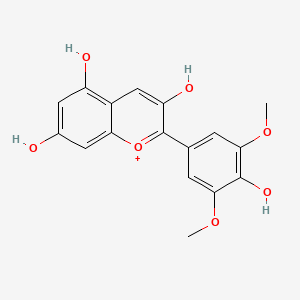| MeSH term | MeSH ID | Detail |
|---|---|---|
| Adenocarcinoma | D000230 | 166 associated lipids |
| Body Weight | D001835 | 333 associated lipids |
Malvidin
Malvidin is a lipid of Polyketides (PK) class. The involved functions are known as conjugation.
Cross Reference
Introduction
To understand associated biological information of Malvidin, we collected biological information of abnormalities, associated pathways, cellular/molecular locations, biological functions, related genes/proteins, lipids and common seen animal/experimental models with organized paragraphs from literatures.
What diseases are associated with Malvidin?
There are no associated biomedical information in the current reference collection.
Possible diseases from mapped MeSH terms on references
We collected disease MeSH terms mapped to the references associated with Malvidin
PubChem Associated disorders and diseases
What pathways are associated with Malvidin
There are no associated biomedical information in the current reference collection.
PubChem Biomolecular Interactions and Pathways
Link to PubChem Biomolecular Interactions and PathwaysWhat cellular locations are associated with Malvidin?
There are no associated biomedical information in the current reference collection.
What functions are associated with Malvidin?
Related references are published most in these journals:
| Function | Cross reference | Weighted score | Related literatures |
|---|
What lipids are associated with Malvidin?
There are no associated biomedical information in the current reference collection.
What genes are associated with Malvidin?
There are no associated biomedical information in the current reference collection.
What common seen animal models are associated with Malvidin?
There are no associated biomedical information in the current reference collection.
NCBI Entrez Crosslinks
All references with Malvidin
Download all related citations| Authors | Title | Published | Journal | PubMed Link |
|---|---|---|---|---|
| Arapitsas P et al. | A metabolomic approach to the study of wine micro-oxygenation. | 2012 | PLoS ONE | pmid:22662221 |
| Chen XQ et al. | Anti-oxidative analysis, and identification and quantification of anthocyanin pigments in different coloured rice. | 2012 | Food Chem | pmid:22980872 |
| Acevedo De la Cruz A et al. | Anthocyanin identification and composition of wild Vitis spp. accessions by using LC-MS and LC-NMR. | 2012 | Anal. Chim. Acta | pmid:22688046 |
| Zubair M et al. | Characterization of high-value bioactives in some selected varieties of Pakistani Rice (Oryza sativa L.). | 2012 | Int J Mol Sci | pmid:22605998 |
| Kamonpatana K et al. | Susceptibility of anthocyanins to ex vivo degradation in human saliva. | 2012 | Food Chem | pmid:22868153 |
| Veskoukis AS et al. | The antioxidant effects of a polyphenol-rich grape pomace extract in vitro do not correspond in vivo using exercise as an oxidant stimulus. | 2012 | Oxid Med Cell Longev | pmid:22693650 |
| Vauzour D | Dietary polyphenols as modulators of brain functions: biological actions and molecular mechanisms underpinning their beneficial effects. | 2012 | Oxid Med Cell Longev | pmid:22701758 |
| Ganugapati J et al. | Molecular docking studies of banana flower flavonoids as insulin receptor tyrosine kinase activators as a cure for diabetes mellitus. | 2012 | Bioinformation | pmid:22493522 |
| Rodriguez-Mateos A et al. | Procyanidin, anthocyanin, and chlorogenic acid contents of highbush and lowbush blueberries. | 2012 | J. Agric. Food Chem. | pmid:22175691 |
| Stiaccini G et al. | Resveratrol-poor red wines modulate SIRT1 in human renal cells. | 2012 | Plant Foods Hum Nutr | pmid:22706671 |
